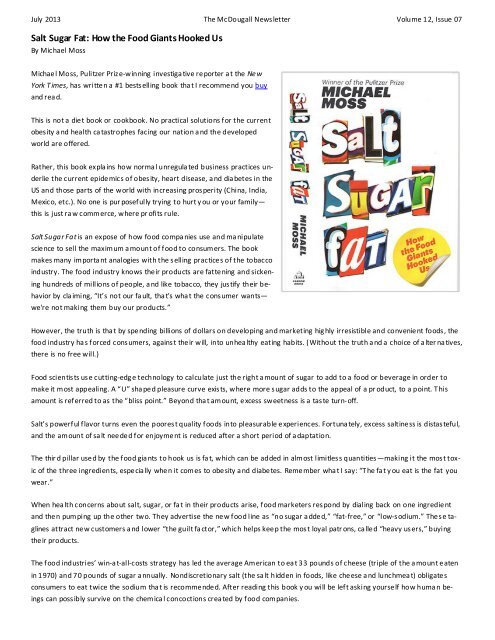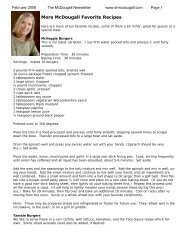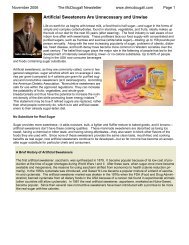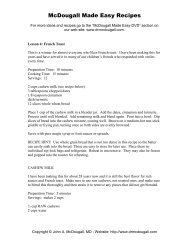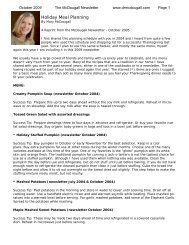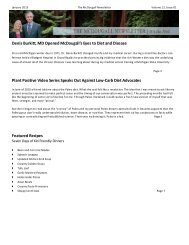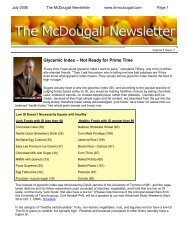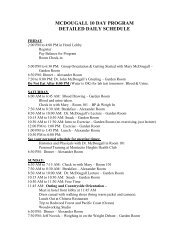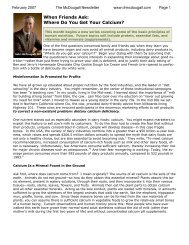Printer Friendly PDF - Dr. McDougall
Printer Friendly PDF - Dr. McDougall
Printer Friendly PDF - Dr. McDougall
You also want an ePaper? Increase the reach of your titles
YUMPU automatically turns print PDFs into web optimized ePapers that Google loves.
July 2013 The <strong>McDougall</strong> Newsletter Volume 12, Issue 07Salt Sugar Fat: How the Food Giants Hooked UsBy Michael MossMichael Moss, Pulitzer Prize-winning investiga tive reporter a t the Ne wYork T imes, has written a #1 bestselling book tha t I recommend you buyand rea d.This is not a diet book or cookbook. No practical solutions for the currentobesity a nd health ca tastrophes facing our nation a nd the developedworld are offered.Rather, this book expla ins how norma l unregula ted business practices underliethe current epidemics of obesity, heart disease, a nd dia betes in theUS and those parts of the world with increasing prosperity (China, India,Mexico, etc.). No one is pur posefully trying to hurt y ou or your family—this is just ra w commerce, where pr ofits rule.Salt Sugar Fat is an expose of how food compa nies use and ma nipulatescience to sell the maximum a mount of food to consumers. The bookmakes many importa nt analogies with the selling practices of the tobaccoindustry. The food industry knows their products are fattening and sickeninghundreds of millions of people, a nd like tobacco, they justify their behaviorby cla iming, “It’s not our fa ult, tha t's wha t the consumer wants—we're not making them buy our products.”However, the truth is tha t by spending billions of dollars on developing and marketing hig hly irresistible and convenient foods, thefood industry ha s forced consumers, against their will, into unhea lthy eating habits. (Without the truth a nd a choice of a lter na tives,there is no free will.)Food scientists use cutting-edg e technology to calculate just the right a mount of sugar to add to a food or beverage in order tomake it most appealing. A “U” sha ped pleasure curve exists, where more sugar adds to the appeal of a pr oduct, to a point. Thisamount is referred to as the “bliss point.” Beyond tha t amount, excess sweetness is a taste turn-off.Salt’s powerful flavor turns even the poorest quality foods into pleasurable experiences. Fortuna tely, excess saltiness is distasteful,and the amount of sa lt needed for enjoyment is reduced after a short period of a daptation.The thir d pillar used by the food gia nts to hook us is fa t, which can be added in almost limitless quantities —making it the most toxicof the three ingredients, especia lly when it comes to obesity a nd diabetes. Remember wha t I say: “T he fa t y ou eat is the fat youwear.”When hea lth concerns about salt, sugar, or fa t in their products arise, food marketers respond by dialing back on one ingredientand then pumping up the other two. They advertise the new food line as “no sugar a dded,” “fat-free,” or “low-sodium.” These taglinesattract new customers a nd lower “the guilt fa ctor,” which helps keep the most loyal patr ons, ca lled “heavy users,” buyingtheir products.The food industries’ win-at-all-costs strategy has led the average American to ea t 33 pounds of cheese (triple of the a mount eatenin 1970) and 70 pounds of sugar a nnually. Nondiscretionary salt (the sa lt hidden in foods, like cheese a nd lunchmea t) obligatesconsumers to eat twice the sodium tha t is recommended. After reading this book y ou will be left asking yourself how huma n beingscan possibly survive on the chemica l concoctions crea ted by food companies.


